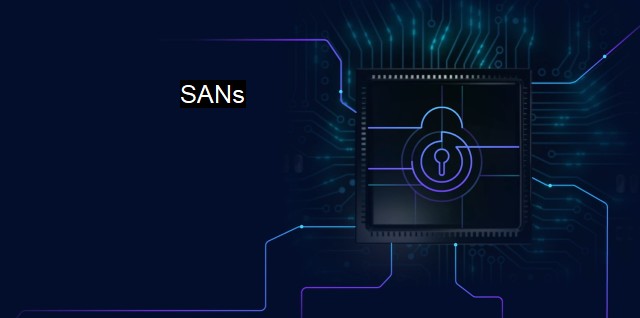What are SANs?
Securing Your Data: The Role of Storage Area Networks (SANs) in Cybersecurity and Antivirus
Storage Area Network (SAN) is a high-speed, specialized network that provides access to block-level storage. SANs are primarily utilized to make storage devices, like disk arrays and tape libraries, accessible to servers so that they appear to the server as locally attached devices. SAN plays a key role.A SAN is like a Local Area Network (LAN) crafted specifically for data storage. Instead of general data or network communication, a SAN is designed and optimized to transport large blocks of stored data. This is due to high-speed interconnections using technology such as Fiber Channel, Internet SCSI (iSCSI) or Ethernet. Simplified, SAN allows your various storages to hook into a network.
SANs often sport their own storage devices which are generally more robust and specialized than common user storage. They can use either a dedicated network infrastructure or share one within an existing framework. In likelihood, they're spread around multiple server environments, encompassing cloud computing, and needing solid security management.
SANs are critical. They can store sensitive data including personal identifiable information and financial reports which can present starving opportunities for hackers. an attacker who successfully infiltrates a SAN can gain unauthorized access to sensitive data and cause serious harm, including data theft, corruption, or destruction. Therefore, it is vital to secure these networks against potential threats.
As the infrastructure of such systems is increasingly complex and interconnected, they have become attractive targets for sophisticated cyber-attacks. It is therefore important to develop robust cybersecurity programs that encompass SANs as part of a comprehensive risk management strategy. The goal is to not only prevent attacks but also to minimize the impact on business functions in the event of a successful attack.
Key measures to protect SANs include strong authentication protocols, data encryption, regular system updates, secure user access controls, traffic analysis, and continuous surveillance for anomalies that might suggest an attack. adequately formatted antivirus software is essential in ensuring the security of the SANs - they can help guard against malware or viruses that may be unleashed on the storage devices connected to the network or come in through network traffic.
Beyond maintaining regular software updates, organizations need to deploy defense-in-depth strategies to secure their SANs. This methodology uses multiple layers of security to guard against attacks. If one security measure fails, another is ready to counter the threat. This approach should be supplemented with regular audits of system access and user behaviour, real-time monitoring of potential threat activities, and rapid deployment of security patches where needed.
Another vital aspect of SAN security is training, often overlooked but exceptionally useful. Regular training of IT personnel in understanding latest threats and countermeasures, alongside frequent awareness campaigns for general staff about good cybersecurity hygiene, can significantly help counter successful attacks.
An antivirus for SAN can be built in parallel to the other storage network. This will not only protect stored data but will also scan the network for potential threats, malware, and can provide needed additional layers of security.
They might need to accomplish thorough scanning for malware regularly to minimize the risk of incursion through zero-day vulnerabilities, which are the vulnerabilities that software creators aren't even aware exist, and therefore, no patches are available for them. Detecting and mitigating these vulnerabilities becomes even more important in a SAN setup, given the magnitude of data at risk.
Strengthening the security of SAN not only helps keep critical and sensitive data safe, it also supports business continuity in a world where data is a critical asset. As the complexity of SANs continues to increase, the tools and strategies used to protect them also require constant updating and revising. Dedicated cybersecurity solution providers can help organizations in ensuring they have the most optimal, customized cyberdefense mechanisms for their SAN infrastructure.
While innovation brings effectiveness and intelligence, along comes the necessary evil of threat with it. Making sure your SAN, hence the data stored on it, has the best possible security measures ensures not just the stability of present operations, but also paves way for more organized, reliable, and flourishing upcoming advancements.

SANs FAQs
What is Sans?
Sans is a non-profit organization that offers cybersecurity training and certification programs to individuals and organizations.What kind of cybersecurity training programs does Sans offer?
Sans offers a wide range of cybersecurity training programs, including courses on network security, incident response, penetration testing, and digital forensics.Is Sans an antivirus software?
No, Sans is not an antivirus software. It is an organization that provides cybersecurity training and certification programs to individuals and companies.How can I get certified by Sans?
To get certified by Sans, you need to complete one or more of their certification programs and pass the associated exam. You can enroll in their courses either online or in-person, depending on your preference.| | A | | | B | | | C | | | D | | | E | | | F | | | G | | | H | | | I | | | J | | | K | | | L | | | M | |
| | N | | | O | | | P | | | Q | | | R | | | S | | | T | | | U | | | V | | | W | | | X | | | Y | | | Z | |
| | 1 | | | 2 | | | 3 | | | 4 | | | 7 | | | 8 | | |||||||